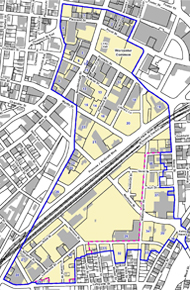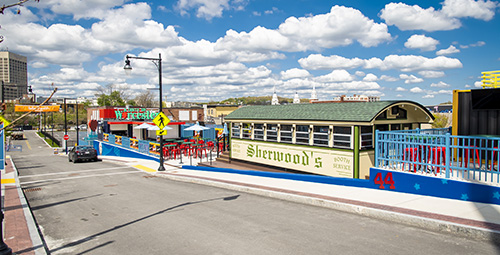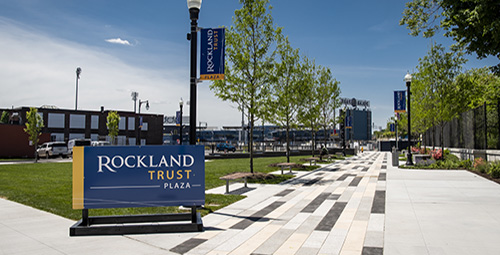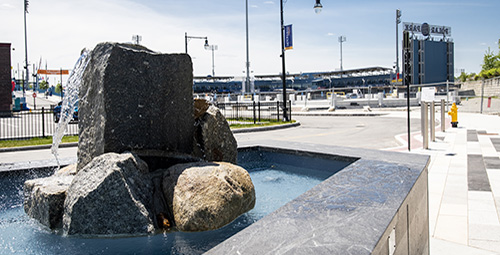Urban Renewal
Originated in the 1939 Federal Housing Act's authorities for slum clearance and construction of public housing in the nation's rapidly deteriorating inner cities, urban renewal was introduced to Worcester in the 1950s and 1960s. In Massachusetts, urban renewal is governed by M.G.L. Chapter 121B, as well as 760 Code of Massachusetts Regulations (CMR) 12.00, with oversight provided by the Commonwealth's Department of Housing and Community Development (DHCD). The urban renewal program invests the WRA, as a designated urban renewal agency, with certain powers to catalyze development within an urban renewal area. Using a combination of public and private funds, urban renewal plans establish local area goals and provide for public infrastructure investment and the public acquisition and disposition of certain properties in order to carry out the plan. Urban renewal powers include the power to determine what areas within its jurisdiction constitute decadent, substandard or blighted open areas, the power to acquire property through eminent domain and access to certain public funding sources.
Over the years, the WRA has been involved in six urban renewal projects in the City of Worcester, including:
- Area D Urban Renewal Project,
- Mass. R-15 Elm Park Urban Renewal Project,
- Mass. R-57 Expressway Urban Renewal Project,
- Mass. R-16 New Salem Urban Renewal Project,
- Mass. R-5-1 Medical City Urban Renewal Project (formerly East Central Urban Renewal Plan) - Still Active
- Union Station Urban Renewal Revitalization Plan - Still Active
Downtown Worcester Urban Revitalization (URP) Plan
The Downtown Urban Revitalization Plan (URP) was initiated by the Worcester Redevelopment Authority (WRA) in cooperation with the City of Worcester and the Worcester City Council. The overarching vision of the URP is to build on the current momentum of downtown revitalization through strategic public investments to cultivate a safe and vibrant downtown with a strong and sustainable economic vitality. A revitalized downtown will provide an 18-hour live, work and play environment which offers new opportunities to underperforming properties, connects people and places and capitalizes on Worcester's unique location and characteristics.
The plan focuses on revitalizing the downtown area by publicizing arts and tourism destinations, improving the visitor experience, attracting new or expanding existing commercial and industrial users, enhancing residential quality of life and remediating brownfields to increase developable land area. The Urban Revitalization Area (URA) as amended has an irregularly-shaped boundary comprised of approximately 137 parcels and 412 properties (including approximately 61 business and 214 residential condominium units) within a 137.1-acre area.
At a Glance
- Zoning BG-6, MG-2, RG-5, BG-3, BG-4
- Commercial Corridor Overlay District
- 137.1 Acres
- 27 Properties Identified for Potential Acquisition

Looking Forward
The Downtown Urban Revitalization Plan has many current and upcoming projects underway:
- Polar Park - The City of Worcester and Worcester Red Sox are in their second season at Polar Park. They plan to build upon the successes of the first season and expect many great things.
- Summit Street - The completion of Summit Street also marked the completion of the WooSox Loop, nearly a half-mile loop circumnavigating the ballpark which has already been utilized by local 5K walk events. There are also five active retail vendors in the Summit Street terraces.
- Rockland Trust (Pickett) Plaza - The plaza provides a pedestrian connection from the Green Street Bridge along the new Canal Street and Summit Street entrance of Polar Park. The plaza also features a 90-foot replica of a canal as an homage to the district, complete with a fountain.
- Madison Properties - They broke ground on the first market-rate residential building in summer 2021. The development plan includes a second residential building of at least 125 market-rate units, a hotel and a lab and office building. They are also leasing the new 340-space parking garage across from Polar Park on Green Island Boulevard.
- Boston Capital's Table Talk Lofts - Boston Capital is working on a mixed-use and mixed-income residential development plan, which will include retail space. They are also re-instituting a former public street known as Spruce Street which bisects the site from Green Street to Washington Street.
- The Cove - The Cove is a mixed-use, market-rate residential construction project consisting of 173-units with commercial retail on the first-floor.



Resources
- Downtown Urban Revitalization Plan
- Downtown Urban Revitalization Plan Attachments
- Downtown Urban Revitalization Plan Amendment #1
- Downtown Urban Revitalization Plan Amendment #1 - Attachments
- Downtown Urban Revitalization Plan Amendment #2
- Downtown Urban Revitalization Plan Amendment #3
- City Council Public Hearing Presentation
- Urban Renewal in the Commonwealth of Massachusetts
Contact Information
Address
Economic Development
City Hall 4th Floor
455 Main Street
Worcester, MA 01608
Contact
Phone: 508-799-1400
Fax: 508-799-1406
Email Us
Hours
Monday - Friday
8:30 a.m. - 5 p.m.

